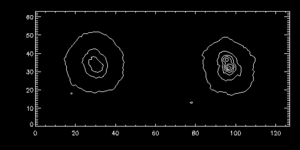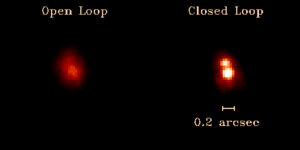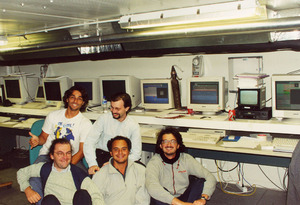First Time Ever use of a Pyramid Wavefront Sensor to Close on Sky the High Orders Adaptive Optics Loop
Nearly diffraction limit images obtained with AdOpt@TNG in K' band
During the night between the 5th and 6th of september, 2001, the Adaptive Optics Team of the Telescopio Nazionale Galileo (AdOpt@TNG), led by R. Ragazzoni, has successfully closed the higher orders loop using the Pyramid WaveFront Sensor mounted on the AdOpt@TNG system. It is the first time ever that this kind of sensor is used in an AO system to close the loop on real stars: it can be considered a milestone for the AO technology!
The result is clearly seen in these K' band, 50sec images of a mv=7.7 star in the direction of Cygnus. The open loop image (on the left) shows a single diffuse object while the closed loop one (on the right) uts in evidence the two components of a double star with ~0.2arcsec separation. The brightest component has a FWHM~0.16arcsec, next to the diffraction limit of the TNG at that wavelength. Strehl ratio, as evaluated from these first result, turns out to be S~0.16. Images were taken through a Neutral Density=2 filter to avoid saturation on the Near Infrared Camera Spectrometer (NICS). The loop was closed at a CCD frame rate of 25Hz.

Contour plot of the previous image
This important result has become a reality thanks to the direct effort of a lot of people and the support of many others who we would like to thank once more from here. (In the meantime we received a private comunication announcing the on bench loop closure with the Pyramid WFS by the AO Team of the Large Binocular Telescope (LBT). Well done!).
In the control room (clockwise from top left): Juan Carlos Guerra, Alfio Puglisi, Adriano Ghedina, Simone Esposito, Roberto Ragazzoni.



